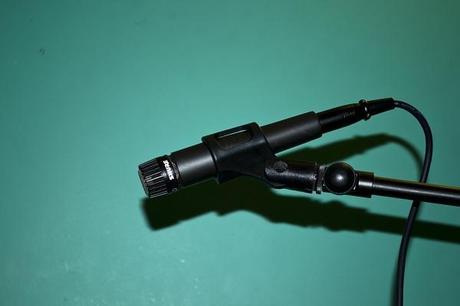Written By: Jacob Morris
Unveiled in 1965, the SM57 from Shure shares a reputation with its sibling the SM58, that is preceded by no other mic in its class. Their durability, versatility and affordability has made them extremely popular choices for amateurs and professionals alike.
Shure in Short

Shure formed in 1925, initially selling radio parts via mail. Only in 1931 did they begin developing microphones. In 1939, what can be seen as an early predecessor to the SM58 was developed: The Model 55 Unidyne, named after its unidirectional polar pattern. The microphone was immortalized in part due to its iconic appearance, even earning it the nickname “The Elvis Mic”. Many different models were produced and while they are still being sold today, the Model 55 Unidyne’s reputation sits firmly in the yesteryear, perhaps due to how distinctly retro it looks today.
“…immortalized in part due to its iconic appearance…”
In the years leading up to the SM57, several other microphones were released in the Unidyne series, most notably the 545 and the 548. The 545 in particular bears a striking resemblance to the SM57 with the main visual difference being in its silver lower half and more tapered design. Unfortunately, these designs have been overshadowed by the SM57, although the 545 is still being manufactured to date.
Trusty SM57 vs. 58
The two microphones are very similar; The 57 and 58 are both cardioid microphones, meaning that they capture sound primarily from where they’re facing, and are both dynamic. In fact, the insides of these microphones are identical: They both use an element dubbed the Unidyne III.

So, considering that the SM57 and SM58 are the same type of microphone and even have the same guts, what sets them apart? Well, they have a slightly different size, shape and weight, but the main difference in sound is caused by the most obvious visual difference: the grill. While the 58 has a sturdy, spherical ball of metal mesh, the 57 uses a small plastic grill with a flatter piece of metal mesh on top. The 58′s ball grill offers better protection, both from physical damage and vocal plosives, however, the ball also causes a slightly altered frequency response, most notably in a mild drop in high end.
“The 58′s ball grill offers better protection, both from physical damage and vocal plosives…”
The ball grill can easily be screwed on and off by hand, leaving a thin piece of foam to protect the diaphragm in its place. This has lead to the misconception that the 57 and 58 are sonically identical once the 58′s ball grill has been taken off. While this does make the microphones appear similar, the foam piece is not identical to the 57′s mesh grill and they will still sound slightly different as a result. At the end of the day though, the two microphones are virtually interchangeable because it is just as easy to fit a separate windscreen on the 57 as it is to take the ball grill off the 58.

Shure Successors to Imitators
Due to its iconic and famous design, the SM58 has its share of imitators. For example, the Samson Q7 bears a striking resemblance. Counterfeit SM58s in particular are a sizeable issue because the differences are not immediately apparent. Outside of the sound itself, small differences in the fake microphones can include being slightly lighter in weight, not numbering the XLR connectors at the bottom and, most deviously of all, not including a Shure bumper sticker in the packaging.
On a more positive note, Shure themselves have embraced the design of the SM58 with the release of the Beta 58. It is a similar to the SM58, but like several of the other products in the Beta line, it is distinguishable by the light blue ring on the grill.
While it is also sold as a vocal microphone, it’s not a simple reboot of the SM58 as it has many differences including extended frequency response, a new supercardioid polar pattern and reduction in handling noise. Shure has also released a budget alternative to the SM58 called the PG58 which is designed more faithfully after the SM58 in both appearance and style.
Shure has earned its place in history with its microphones and it’s certainly not going away. While it’s impossible for a microphone to be truly perfect for everything, the SM57 and SM58 are likely going to be seen and heard on stage and in records for years to come.
Read More: An nterview with South African boutique amp builder Benjamin Craig and our one, two and three part with Daytona Dave about the art of building amps.
Image Sources: auralasia, cantov and thegrid-ch
